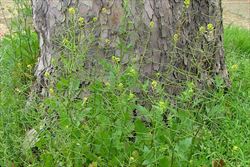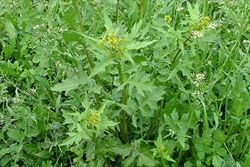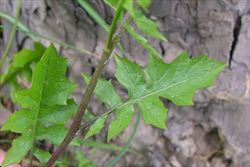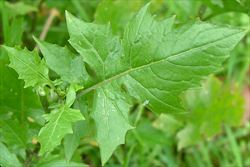Click on images to enlarge

infestation (Photo: Sheldon Navie)

habit (Photo: Sheldon Navie)

stem and deeply-lobed leaves (Photo: Sheldon Navie)

close-up of leaf (Photo: Sheldon Navie)

uppermost leaves and young flower clusters (Photo: Sheldon Navie)

close-up of small yellow flowers and young fruit (Photo: Sheldon Navie)

very narrow immature fruit borne on short stalks (Photo: Sheldon Navie)

seedling (Photo: Sheldon Navie)
Scientific Name
Sisymbrium erysimoides Desf.
Family
Brassicaceae (Queensland, New South Wales, the ACT, Victoria, Tasmania, Western Australia and the Northern Territory)Cruciferae (South Australia)
Common Names
French rocket, Mediterranean rocket, smooth mustard
Origin
Native to northern Africa, the Azores, the Madeira Islands, the Canary Islands, parts of southern Europe, the middle-east, western Asia and Pakistan.
It has sometimes also been considered to be native to large parts of inland Australia.
Naturalised Distribution
Probably widely naturalised in southern and central Australia (i.e. inland southern and central Queensland, western and New South Wales, western and central Victoria, South Australia, the southern parts of the Northern Territory, and the southern and western parts of Western Australia).
Widely naturalised on other parts of the world, including in south-western USA (i.e. California), New Zealand and New Caledonia.
Notes
Smooth mustard (Sisymbrium erysimoides) is mainly found in the drier parts of southern Australia, where it is a weed of crops, pastures, roadsides, parks, gardens, disturbed sites and waste areas. However, it also invades riparian vegetation, grasslands, shrublands and open woodlands, and is sometimes regarded as an environmental weed in Victoria, New South Wales, Western Australia and the Northern Territory.

